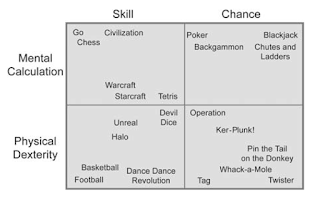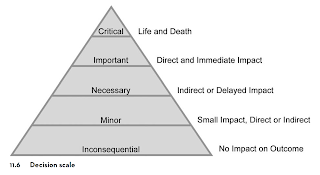Skipping the topics about conceptualization and prototype, we come to playtest, where more general players experience or even participate at it.
Playtesting
Stages
What does playtesting actually does? First, playtesting consists different stages. In each stage, more uncertainties are narrowed and more things are settled down.
In each playtesting, we need to consider our purpose to test, and finding relevant people to test.
Prototyping Stage \ Target |
Your Own |
Confidants |
Target Audience |
Foundations |
● |
|
|
Structure |
● |
● |
|
Formal Details |
|
|
● |
Refinement |
|
|
● |
At first, we need to test our fundamental ideas of the game, test isn't the "fun" we assume at first is really existing in the game. At this stage, our game only contains the core gameplay. The structure is not complete. It needs a lot of implied imagination and explanation while playing it. The picture is still way too far from the final product. So, it is not recommended to invite public or even your friends to
Test Control Situations
Playtesting doesn't mean testing the whole game. You may only choose one level, a certain plot for the players to try. Despite the fact that you may have large resources that can hire players to play your games for hours and days, there will be situations that rarely occurred in normal gameplay.
As we normally let the players to play the start or the middle of the game, we can go further for some specific situations. For example:
- The end of the game
- A random event that rarely takes place
- A special situation within a game
- A particular level of a game
- New features
Playtesting Procedure Notices
At the end, don't forget to ask the testers to leave the contact, since you may invite them again in the later playtesting stages, or give them souvenirs after the game is finished.
The Play Matrix
Different game has different characteristics, we need to consider the pros and cons base on its class. Besides thinking from the types of players, types of objectives that we discussed in previous chapters, we can have a look at The Play Matrix.
Using the above chart can classify you game types, so that you figure out which kind of elements you want to emphasize or eliminate. We can also notice different classes have its own majority of players.Functionality, Completeness, and Balance
|
Functional |
Internally Complete |
Balanced |
Fun |
Accessible |
Foundations |
|
|
|
● |
|
Structure |
● |
|
|
|
|
Formal Details |
● |
● |
● |
|
|
Refinement |
|
|
|
● |
● |
Functional:
Ensure the players can use the controls and make the game progress. Player can follow the rules and procedure to reach the goal without designer’s verbal instructions.
Internally Complete:
It means no gameplay or the functionality needs to be compromised during the game. There will be a clear set of rules that are applicable through the whole game. If some part of the game contradicts with rules or the rules statement are ambiguous, we need to adjust the rules. We also need to check whether loopholes exists. Loopholes will let players exploit themselves while the original gameplay experience is ruined and/or causing other players have bad gameplay experience. Interestingly, when loopholes are found, they can be adjusted and turned to a new feature which riches the gameplay experience.
Balanced:
Variables – objects and resources should be fair. No dominant object
Dynamics(working with the variables) – efforts of procedure and relationship between objects is reasonable
Starting Conditions - everyone is balanced
When considering Balancing, it does not straightly means each side should have the same objects and resources. The principle is to ensuring each side also has the possibility to reach objectives, and during the procedures, no objects and resources should be over relied and dismissed.
There are Symmetrical games and Asymmetrical Games. Symmetrical games really have the same objects for the players and opponents. Asymmetrical Games have many varieties. You may have asymmetrical objects and resources for different players, while their objectives are the same. You may have different objectives while the players share same types of objects and resources.
As game system is dynamic, when player's skill increase, we also need to increase the difficulty of the game. There are two tips to balance the game:
1. Visualize the core gameplay in prototype stage, to clearly identify and purify the purpose, so that you can judge your resources and objects with a more clear perspective.
2. Make one change at a time, so that you notice the effect on changing each element. Using Spreadsheets to list out all variables can help you to approach this process step by step.
Fun and Accessibility
Different players aim for different objectives and challenges, you can see the details in the articles about dramatic elements. Generally, the challenges players want to achieve could be:
- Reaching and Exceeding Goals
- Competing against Opponents
- Stretching Personal Limits
- Exercising Difficult Skills
- Making Interesting Choices
Among from this, we can have a little bit more discover on "making interesting choices". To improve the player choices, we can consider the emergency and importance of the choices
Combine with the technique of dramatic arc, different choices are made to create tension and relaxation. I would say combining the use of the model of Maslow's hierarchy of needs would also help to decide the choices and the emotions of players they will experience.
There are other’s concerns that can have a look:
- Rewards and Punishments
- Anticipation (one signal that gives the players to guess the outcome of the game)
- Surprise
- Progress - milestone (value player's achievements)
- Ending
Finally, please beware of the fun killers elements. They could be:
- Micromanagement - too much for players to control, players will feel annoyed
- Stagnation - repetition of tasks, players will feel bored
- Insurmountable Obstacles - no hints and stuck in current status. Player lost the hope to reach the objective and hence give up the play.
- Arbitrary Events - too unpredictable outcomes, player loses their controls, they will feel like they are being cheated
- Predictable paths - contrary to arbitrary events, there is no surprise, no fresh experience comes out for players to fill up their motivation to keep on playing.
Accessibility:
This mainly concern usability and convenience. It is the best to be carried out from large data. For individuals and small companies, they can only treat it based on the playtesting example they carried out, or hiring a team or specialist to duel with this task.
Conclusion
That's almost the complete procedures to design a game. In the next chapter, we will briefly talk about the external factors related to game design, such as the market, industry aspects.
That's all, meow🐢.



No comments:
Post a Comment